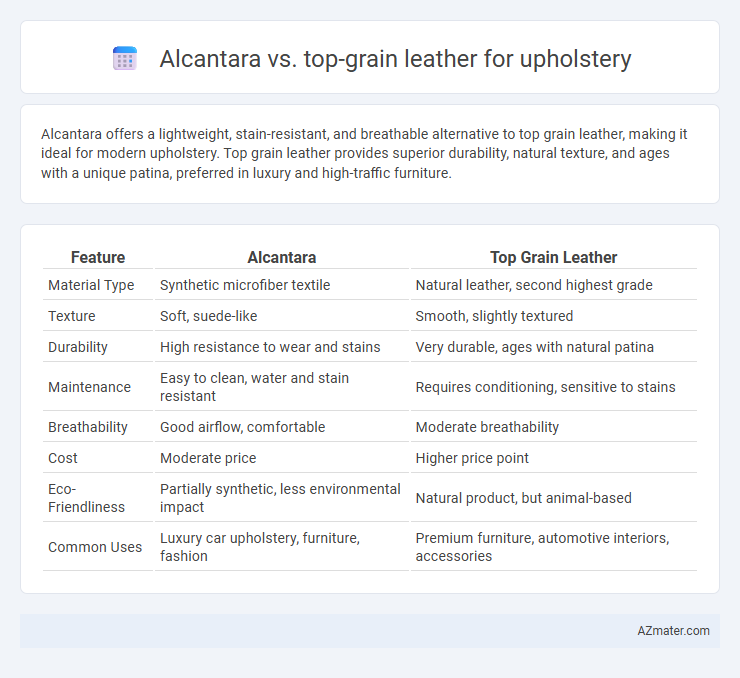Alcantara offers a lightweight, stain-resistant, and breathable alternative to top grain leather, making it ideal for modern upholstery. Top grain leather provides superior durability, natural texture, and ages with a unique patina, preferred in luxury and high-traffic furniture.
Table of Comparison
| Feature | Alcantara | Top Grain Leather |
|---|---|---|
| Material Type | Synthetic microfiber textile | Natural leather, second highest grade |
| Texture | Soft, suede-like | Smooth, slightly textured |
| Durability | High resistance to wear and stains | Very durable, ages with natural patina |
| Maintenance | Easy to clean, water and stain resistant | Requires conditioning, sensitive to stains |
| Breathability | Good airflow, comfortable | Moderate breathability |
| Cost | Moderate price | Higher price point |
| Eco-Friendliness | Partially synthetic, less environmental impact | Natural product, but animal-based |
| Common Uses | Luxury car upholstery, furniture, fashion | Premium furniture, automotive interiors, accessories |
Introduction to Alcantara and Top Grain Leather
Alcantara is a premium synthetic material renowned for its softness, durability, and stain resistance, making it a popular choice for modern upholstery. Top grain leather, derived from the outer layer of the hide, offers superior strength, natural texture, and breathability, providing a timeless and luxurious finish. Both materials serve distinct purposes in upholstery, with Alcantara excelling in maintenance ease and Top grain leather standing out for its authenticity and rugged elegance.
Material Composition and Manufacturing Process
Alcantara is a synthetic microfiber material composed primarily of polyester and polyurethane, produced through a complex non-woven manufacturing process that bonds fibers to create a soft, suede-like texture with high durability and stain resistance. Top grain leather, derived from the upper layer of cowhide, undergoes natural tanning and finishing processes that preserve the grain surface, offering breathability, strength, and a luxurious, authentic leather feel. The manufacturing of Alcantara emphasizes consistency and uniformity in texture, while top grain leather requires careful selection and skilled craftsmanship to maintain its natural variations and enhance its aesthetic quality.
Appearance and Texture Comparison
Alcantara offers a smooth, suede-like texture with a matte finish that feels soft and luxurious, while top grain leather boasts a natural grain pattern with a polished, slightly glossy surface offering a classic and upscale appearance. The synthetic Alcantara resists stains and fading better, maintaining a consistent color and texture over time, whereas top grain leather develops a distinctive patina, enhancing its character but requiring more maintenance. Alcantara's uniform texture contrasts with the varied natural imperfections of top grain leather, making each material uniquely appealing depending on the desired aesthetic and tactile experience.
Durability and Longevity
Alcantara offers superior resistance to stains and fading, making it highly durable for upholstery in high-traffic areas. Top grain leather excels in longevity due to its natural toughness and ability to develop a patina over time, enhancing its aesthetic appeal. Both materials provide excellent durability, but Alcantara is better suited for environments where moisture and spills are common, while top grain leather withstands wear and tear from daily use more effectively.
Comfort and Feel
Alcantara offers a soft, suede-like texture that provides a luxurious and breathable feel, making it ideal for upholstery in warmer climates due to its excellent moisture-wicking properties. Top grain leather delivers a smooth, firm surface with a natural grain, offering durability and a classic, rich aroma that enhances comfort over time as it softens with use. While Alcantara excels in providing a plush, lightweight seating experience, top grain leather is preferred for its robust feel and ability to develop a patina, balancing comfort with longevity.
Maintenance and Cleaning Requirements
Alcantara requires minimal maintenance, with regular vacuuming and occasional spot cleaning using mild soap and water, making it resistant to stains and easy to preserve its appearance. Top grain leather demands more intensive care, including conditioning every 6 to 12 months to prevent drying and cracking, and careful cleaning with leather-specific products to maintain its durability and natural sheen. Both materials benefit from prompt attention to spills, but Alcantara offers a more user-friendly cleaning process for upholstery in high-traffic areas.
Cost and Value Analysis
Alcantara offers a cost-effective alternative to top grain leather, typically priced 30-50% lower while delivering high durability and stain resistance, making it ideal for high-traffic upholstery. Top grain leather commands a premium due to its natural texture, breathability, and aging characteristics, providing long-term value through enhanced comfort and timeless aesthetics. Evaluating total ownership cost, Alcantara minimizes maintenance expenses whereas top grain leather may require more upkeep but often appreciates in value over time due to its premium status.
Environmental Impact and Sustainability
Alcantara upholstery is known for its eco-friendly production process, utilizing recycled polyester and polyurethane components that reduce raw material waste and lower carbon emissions compared to traditional leather tanning. Top grain leather involves resource-intensive cattle farming, heavy water use, and chemical treatments that contribute significantly to environmental degradation and higher greenhouse gas emissions. Choosing Alcantara supports sustainability efforts through its recyclable materials and lower ecological footprint, making it a favorable option for environmentally conscious interior design.
Suitability for Different Environments
Alcantara offers exceptional durability and resistance to stains and fading, making it highly suitable for high-traffic and humidity-prone environments such as cars and commercial spaces. Top grain leather, with its natural breathability and ease of maintenance, excels in creating a luxurious aesthetic ideal for residential interiors with moderate use. Both materials perform well in different conditions, but Alcantara is preferred for more demanding environments while top grain leather suits elegant, less aggressive settings.
Which Is Best for Upholstery?
Alcantara offers a luxurious, suede-like texture with superior stain resistance and easier maintenance, making it ideal for high-traffic upholstery. Top grain leather provides exceptional durability, natural breathability, and a classic aesthetic that improves with age, suiting traditional and long-lasting furniture pieces. Choosing the best depends on whether you prioritize easy cleaning and a modern look (Alcantara) or timeless durability and natural material appeal (top grain leather).

Infographic: Alcantara vs Top grain leather for Upholstery
 azmater.com
azmater.com